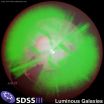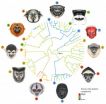(Press-News.org) January 11, 2012 -- New research conducted in the Center for Infection and Immunity (CII) at Columbia University's Mailman School of Public Health, reports that children with autism and gastrointestinal disturbances have high levels of a bacterium called Sutterella in their intestines.
Study findings are published online in the journal mBio.
The investigators found that over half of the children diagnosed with autism and gastrointestinal disturbances had Sutterella in intestinal biopsy tissue, while Sutterella was absent in biopsies from typically developing children with gastrointestinal disturbances. Not only was Sutterella present in the intestines of children with autism, but relative to most genera of bacteria, Sutterella was present at remarkably high levels. Sutterella species have been isolated from human infections previous to this study, but it remains unclear whether this bacterium is a human pathogen.
"These findings shine a light on a bacterium about which we know very little, in a disorder for which we have few answers," says Brent Williams, PhD, the lead author on the study. "There is much work to be done toward understanding the role Sutterella plays in autism, the microbiota, infections, and inflammation."
The researchers examined intestinal biopsies from 32 patients, 23 diagnosed with autism and 9 typically developing children. While previous studies investigating a link between the microbiota and autism have utilized stool samples, the study was unique in investigating bacteria adherent to the intestinal wall, which may be different than what is shed in the stool. Furthermore, the researchers designed and applied novel Sutterella-specific molecular assays to enable detection, quantitation, and phylogenetic analysis of Sutterella species in biological and environmental samples.
Many children with autism have gastrointestinal problems that can complicate clinical management and contribute to behavioral disturbances. However, the underlying reason that autism is associated with gastrointestinal disturbances is unknown.
"Although caution in interpretation is indicated because this is a small cohort, microbiome research may provide new insights into gastrointestinal disturbances that develop in children with autism," notes Mady Hornig, MD, Mailman School associate professor and director of Translational Research at the CII.
###
About Columbia University's Mailman School of Public Health
Founded in 1922 as one of the first three public health academies in the nation, Columbia University's Mailman School of Public Health pursues an agenda of research, education, and service to address the critical and complex public health issues affecting New Yorkers, the nation and the world. The Mailman School is the third largest recipient of NIH grants among schools of public health. Its over 300 multi-disciplinary faculty members work in more than 100 countries around the world, addressing such issues as preventing infectious and chronic diseases, environmental health, maternal and child health, health policy, climate change & health, and public health preparedness. It is a leader in public health education with over 1,000 graduate students from more than 40 nations pursuing a variety of master's and doctoral degree programs. The Mailman School is also home to numerous world-renowned research centers including the International Center for AIDS Care and Treatment Programs (ICAP), the National Center for Disaster Preparedness, and the Center for Infection and Immunity. For more information, please visit www.mailman.columbia.edu
A clue to the GI problems that plague many kids with autism?
New study finds that children with autism and gastrointestinal symptoms have high levels of the bacterium Sutterella in their gut
2012-01-13
ELSE PRESS RELEASES FROM THIS DATE:
Treatment with light benefits Alzheimer's patients, Wayne State University finds
2012-01-13
Detroit - Exposure to light appears to have therapeutic effects on Alzheimer's disease patients, a Wayne State University researcher has found.
In a study published recently in the Western Journal of Nursing Research, LuAnn Nowak Etcher, Ph.D., assistant professor of nursing, reported that patients treated with blue-green light were perceived by their caregivers as having improved global functioning.
Caregivers said patients receiving the treatment seemed more awake and alert, were more verbally competent and showed improved recognition, recollection and motor coordination. ...
Rice's 'quantum critical' theory gets experimental boost
2012-01-13
New evidence this week supports a theory developed five years ago at Rice University to explain the electrical properties of several classes of materials -- including unconventional superconductors -- that have long vexed physicists.
The findings in this week's issue of Nature Materials uphold a theory first offered in 2006 by physicist Qimiao Si, Rice's Harry C. and Olga K. Wiess Professor of Physics and Astronomy. They represent an important step toward the ultimate goal of creating a unified theoretical description of the quantum behavior of high-temperature superconductors ...
ISG15: A novel therapeutic target to slow breast cancer cell motility
2012-01-13
Interferon-stimulated gene 15 (ISG15), a ubiquitin like protein, is highly elevated in a variety of cancers including breast cancer. How the elevated ISG15 pathway contributes to tumorigenic phenotypes remains unclear and is the subject of a study published in the January 2012 issue of Experimental Biology and Medicine. Dr. Shyamal Desai and her co-investigators from the Louisiana State University School of Medicine in New Orleans, the University of Pennsylvania School of Medicine in Philadelphia, and the Robert Wood Johnson School of Medicine in New Jersey report that ...
Calculating what's in the universe from the biggest color 3-D map
2012-01-13
Since 2000, the three Sloan Digital Sky Surveys (SDSS I, II, III) have surveyed well over a quarter of the night sky and produced the biggest color map of the universe in three dimensions ever. Now scientists at the U.S. Department of Energy's Lawrence Berkeley National Laboratory (Berkeley Lab) and their SDSS colleagues, working with DOE's National Energy Research Scientific Computing Center (NERSC) based at Berkeley Lab, have used this visual information for the most accurate calculation yet of how matter clumps together – from a time when the universe was only half its ...
Stenting for stroke prevention becoming safer in high-risk patients
2012-01-13
MADISON –Placing a stent in a key artery in the neck is safer than ever in patients ineligible for the standard surgical treatment of carotid artery disease, according to a new study published online today in the Journal of Vascular Surgery.
A team of researchers led by Dr. Jon Matsumura, head of the vascular surgery division at University of Wisconsin School of Medicine and Public Health, found the clinical trial PROTECT (Carotid Artery Stenting with Distal Embolic Protection with Improved System) had the lowest rate of complications ever in patients considered high ...
Evolution is written all over your face
2012-01-13
Why are the faces of primates so dramatically different from one another?
UCLA biologists working as "evolutionary detectives" studied the faces of 129 adult male primates from Central and South America, and they offer some answers in research published today, Jan. 11, in the early online edition of the journal Proceedings of the Royal Society B. The faces they studied evolved over at least 24 million years, they report.
"If you look at New World primates, you're immediately struck by the rich diversity of faces," said Michael Alfaro, a UCLA associate professor ...
UMass Amherst chemical engineers boost petrochemical output from biomass by 40 percent
2012-01-13
AMHERST, Mass. – Chemical engineers at the University of Massachusetts Amherst, using a catalytic fast pyrolysis process that transforms renewable non-food biomass into petrochemicals, have developed a new catalyst that boosts the yield for five key "building blocks of the chemical industry" by 40 percent compared to previous methods. This sustainable production process, which holds the promise of being competitive and compatible with the current petroleum refinery infrastructure, has been tested and proven in a laboratory reactor, using wood as the feedstock, the research ...
Hubble breaks new ground with discovery of distant exploding star
2012-01-13
NASA's Hubble Space Telescope has looked deep into the distant universe and detected the feeble glow of a star that exploded more than 9 billion years ago. The sighting is the first finding of an ambitious survey that will help astronomers place better constraints on the nature of dark energy, the mysterious repulsive force that is causing the universe to fly apart ever faster.
"For decades, astronomers have harnessed the power of Hubble to unravel the mysteries of the universe," said John Grunsfeld, associate administrator for NASA's Science Mission Directorate in Washington. ...
LSU professor discovers world's tiniest vertebrate
2012-01-13
BATON ROUGE – LSU's Chris Austin recently discovered two new species of frogs in New Guinea, one of which is now the world's tiniest known vertebrate, averaging only 7.7 millimeters in size – less than one-third of an inch. It ousts Paedocypris progenetica, an Indonesian fish averaging more than 8 millimeters, from the record. Austin, leading a team of scientists from the United States including LSU graduate student Eric Rittmeyer, made the discovery during a three-month long expedition to the island of New Guinea, the world's largest and tallest tropical island.
"It ...
New species of tiny frog is world's smallest vertebrate
2012-01-13
Researchers have found two new frog species in New Guinea, one of which is the new smallest known vertebrate on Earth. The results are reported in the Jan. 11 issue of the online journal PLoS ONE, and the team of researchers was led by Christopher Austin of Louisiana State University.
The new smallest vertebrate species is called Paedophryne amauensis, named after Amau Village in Papua New Guinea, where it was found. The adult body size for these frogs ranges from just 7.0 to 8.0 millimeters.
According to Dr. Austin, the discovery "is of considerable interest to biologists ...
LAST 30 PRESS RELEASES:
A new way to map how cells choose their fate
Numbers in our sights affect how we perceive space
SIMJ announces global collaborative book project in commemoration of its 75th anniversary
Air pollution exposure and birth weight
Obstructive sleep apnea risk and mental health conditions among older adults
How talking slows eye movements behind the wheel
The Ceramic Society of Japan’s Oxoate Ceramics Research Association launches new international book project
Heart-brain connection: international study reveals the role of the vagus nerve in keeping the heart young
Researchers identify Rb1 as a predictive biomarker for a new therapeutic strategy in some breast cancers
Survey reveals ethical gaps slowing AI adoption in pediatric surgery
Stimulant ADHD medications work differently than thought
AI overestimates how smart people are, according to HSE economists
HSE researchers create genome-wide map of quadruplexes
Scientists boost cell "powerhouses" to burn more calories
Automatic label checking: The missing step in making reliable medical AI
Low daily alcohol intake linked to 50% heightened mouth cancer risk in India
American Meteorological Society announces Rick Spinrad as 2026 President-Elect
Biomass-based carbon capture spotlighted in newly released global climate webinar recording
Illuminating invisible nano pollutants: advanced bioimaging tracks the full journey of emerging nanoscale contaminants in living systems
How does age affect recovery from spinal cord injury?
Novel AI tool offers prognosis for patients with head and neck cancer
Fathers’ microplastic exposure tied to their children’s metabolic problems
Research validates laboratory model for studying high-grade serous ovarian cancer
SIR 2026 delivers transformative breakthroughs in minimally invasive medicine to improve patient care
Stem Cell Reports most downloaded papers of 2025 highlight the breadth and impact of stem cell research
Oxford-led study estimates NHS spends around 3% of its primary and secondary care budget on the health impacts of heat and cold in England
A researcher’s long quest leads to a smart composite breakthrough
Urban wild bees act as “microbial sensors” of city health.
New study finds where you live affects recovery after a hip fracture
Forecasting the impact of fully automated vehicle adoption on US road traffic injuries
[Press-News.org] A clue to the GI problems that plague many kids with autism?New study finds that children with autism and gastrointestinal symptoms have high levels of the bacterium Sutterella in their gut


